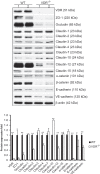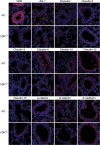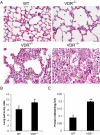Vitamin D Receptor Deletion Leads to the Destruction of Tight and Adherens Junctions in Lungs
- PMID: 30409076
- PMCID: PMC6389123
- DOI: 10.1080/21688370.2018.1540904
Vitamin D Receptor Deletion Leads to the Destruction of Tight and Adherens Junctions in Lungs
Abstract
Vitamin D deficiency has been linked to various inflammatory diseases in lungs, including pneumonia, asthma and chronic obstructive pulmonary disease. However, the mechanisms by which vitamin D and vitamin D receptor reduce inflammation in lung diseases remain poorly understood. In this study, we investigated the expression and cell-specific distribution of tight and adherens junctions in the lungs of vitamin D receptor-deficient (VDR-/-) mice. Our results demonstrated that mRNA and protein levels of claudin-2, claudin-4 and claudin-12 were significantly decreased in the lungs of VDR-/- mice. Other tight and adherens junction proteins, such as ZO-1, occludin, claudin-10, β-catenin, and VE-cadherin, showed significant differences in expression in the lungs of VDR-/- and wild-type mice. These data suggest that altered expression of tight and adherens junction molecules, especially of claudin-2, -4, -10, -12, and -18, after chronic pneumonia caused by VDR deletion could increase lung permeability.Therefore, VDR may play an important role in maintaining pulmonary barrier integrity. Further studies should confirm whether vitamin D/VDR is beneficial for the prevention or treatment of lung diseases.
Keywords: COPD; Claudin; Vitamin D; adherens junctions; chronic pneumonia; epithelial cells; lung permeability; tight junctions; vitamin D receptor.
Figures






Similar articles
-
Vitamin D/VDR signaling attenuates lipopolysaccharide‑induced acute lung injury by maintaining the integrity of the pulmonary epithelial barrier.Mol Med Rep. 2016 Feb;13(2):1186-94. doi: 10.3892/mmr.2015.4685. Epub 2015 Dec 14. Mol Med Rep. 2016. PMID: 26675943 Free PMC article.
-
Vitamin D receptor knockout mice exhibit elongated intestinal microvilli and increased ezrin expression.Nutr Res. 2016 Feb;36(2):184-92. doi: 10.1016/j.nutres.2015.10.005. Epub 2015 Oct 23. Nutr Res. 2016. PMID: 26606857
-
Tight junction CLDN2 gene is a direct target of the vitamin D receptor.Sci Rep. 2015 Jul 27;5:10642. doi: 10.1038/srep10642. Sci Rep. 2015. PMID: 26212084 Free PMC article.
-
MicroRNA Regulation of Endothelial Junction Proteins and Clinical Consequence.Mediators Inflamm. 2016;2016:5078627. doi: 10.1155/2016/5078627. Epub 2016 Nov 24. Mediators Inflamm. 2016. PMID: 27999452 Free PMC article. Review.
-
Vitamin D Receptor Influences Intestinal Barriers in Health and Disease.Cells. 2022 Mar 27;11(7):1129. doi: 10.3390/cells11071129. Cells. 2022. PMID: 35406694 Free PMC article. Review.
Cited by
-
Mini-Review on the Roles of Vitamin C, Vitamin D, and Selenium in the Immune System against COVID-19.Molecules. 2020 Nov 16;25(22):5346. doi: 10.3390/molecules25225346. Molecules. 2020. PMID: 33207753 Free PMC article. Review.
-
Vitamin D and immuno-pathology of COVID-19: many interactions but uncertain therapeutic benefits.Expert Rev Anti Infect Ther. 2021 Oct;19(10):1245-1258. doi: 10.1080/14787210.2021.1905519. Epub 2021 Apr 1. Expert Rev Anti Infect Ther. 2021. PMID: 33739215 Free PMC article. Review.
-
Vitamin D Regulation of Immune Function.Curr Osteoporos Rep. 2022 Jun;20(3):186-193. doi: 10.1007/s11914-022-00732-z. Epub 2022 May 4. Curr Osteoporos Rep. 2022. PMID: 35507293 Free PMC article. Review.
-
Effects of repeated infections with non-typeable Haemophilus influenzae on lung in vitamin D deficient and smoking mice.Respir Res. 2022 Mar 2;23(1):40. doi: 10.1186/s12931-022-01962-6. Respir Res. 2022. PMID: 35236342 Free PMC article.
-
Vitamin D regulation of immune function during covid-19.Rev Endocr Metab Disord. 2022 Apr;23(2):279-285. doi: 10.1007/s11154-021-09707-4. Epub 2022 Jan 29. Rev Endocr Metab Disord. 2022. PMID: 35091881 Free PMC article. Review.
References
Publication types
MeSH terms
Substances
Grants and funding
LinkOut - more resources
Full Text Sources
